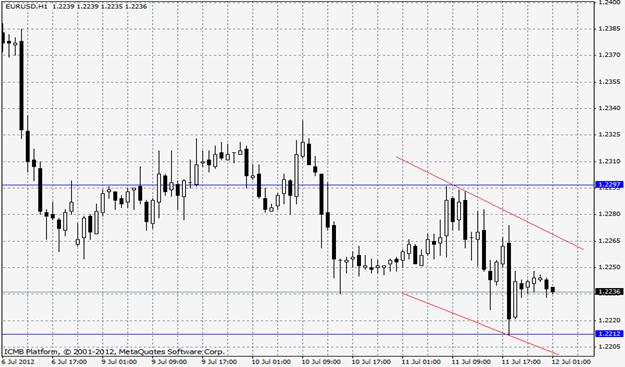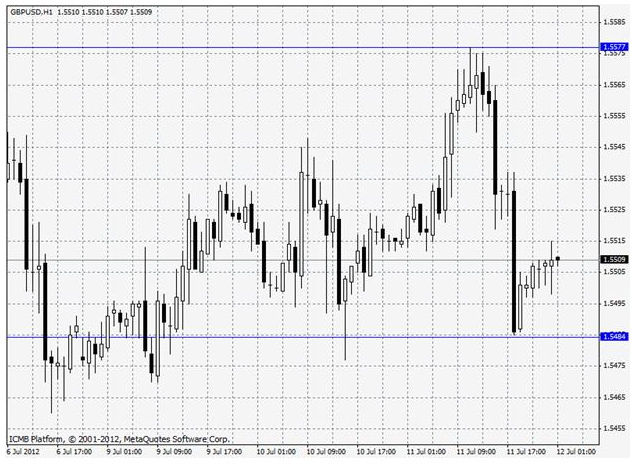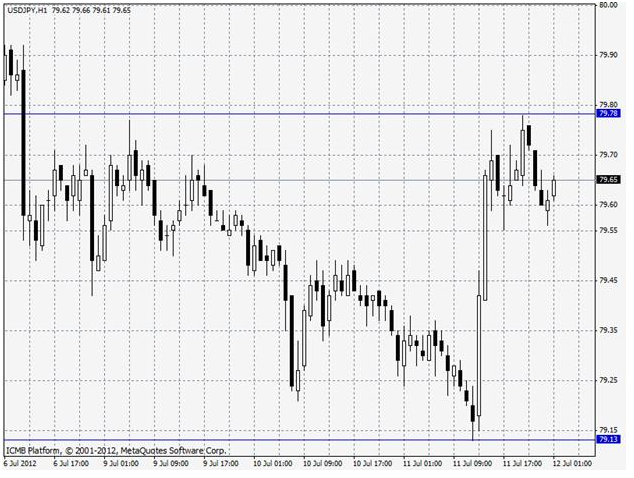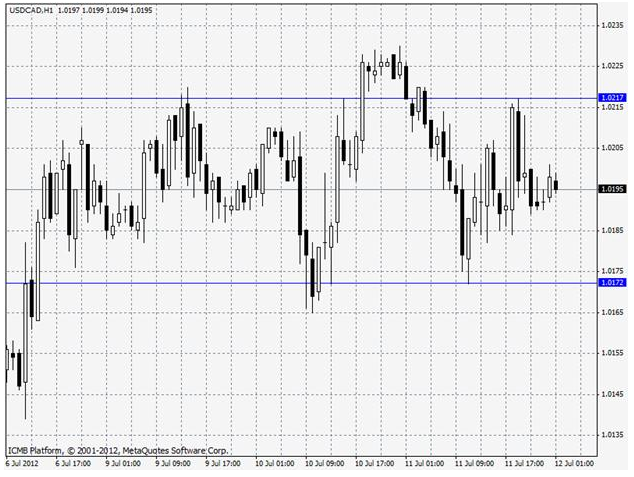The dollar rose to a two-year high versus the euro as minutes of the Federal Reserve’s June meeting disappointed speculators who had bet policy makers would signal a need for more monetary stimulus, driving investors to the greenback as a refuge against slower global economic growth. The dollar advanced as much as 0.3 percent against the euro to $1.2213, the strongest level since July 2010. A very disappointing minutes, however, members of the committee are divided in fact “a few members” expressed the view that further policy stimulus likely would be necessary to promote satisfactory growth in employment and to ensure that the inflation rate would be at the Committee’s goal.
In other words, the Fed is on hold for further market deterioration and that would be the right time for QE3. Meanwhile, Spanish Prime Minister Mariano Rajoy announced cuts in unemployment benefits and public wages, signaled reductions in pensions and raised sales taxes as part of a 65 billion-euro ($80 billion) package of deficit cuts, risking a deeper recession. The measures announced are part of the austerity on a 100 billion-euro bank rescue package. EUR/USD" title="EUR/USD" width="1366" height="652">
EUR/USD" title="EUR/USD" width="1366" height="652">
GBP/USD
The pound rose to the strongest since November 2008 against the euro as concern that legislation needed for Europe’s permanent bailout fund will be delayed boosted demand for the relative safety of the U.K. currency. The pound advanced 0.2 percent to 78.82 pence per euro after appreciating to 78.71 pence, the strongest level since Nov. 3, 2008. The U.K. currency rose less than 0.1 percent to $1.5521. It earlier climbed as much as 0.4 percent, the most since 29th of June. It weakened after no indication of further asset purchase from the Fed. However, the minutes somehow gave us a hint of when the right time to initiate QE3 will be.
The U.K. is scheduled to sell 3.5 billion pounds of bonds maturing in September 2022 at an auction later. U.K. government debt has returned 3 percent this year, according to indexes compiled by Bloomberg and the European Federation of Financial Analysts Societies. Treasurys rose 2.5 percent, and German Bunds climbed 3.6 percent. GBP/USD" title="GBP/USD" width="637" height="465">
GBP/USD" title="GBP/USD" width="637" height="465">
USD/JPY
An index measuring tertiary industry activity in Japan was up a seasonally adjusted 0.7 percent on month in May, the Ministry of Economy, Trade and Industry said, coming in with a score of 99.1. That was well above forecasts for an increase of 0.2 percent following the 0.3 percent contraction in April. Industries that were higher included wholesale and retail trade, medical health care and welfare, information and communications, amusement services, technical services, and compound services. Industries that were down included finance and insurance, electricity, gas, heat and water, real estate and accommodations.  USD/JPY" title="USD/JPY" width="634" height="478">
USD/JPY" title="USD/JPY" width="634" height="478">
USD/CAD
Canada’s dollar rose against its U.S. counterpart after minutes of June’s Federal Reserve meeting showed “a few” policy makers supported expanding monetary stimulus measures. The currency briefly pared gains as stocks fell amid disappointment the U.S. central bank didn’t provide a stronger signal of plans to bolster the economy of Canada’s largest trading partner. Canada’s currency appreciated 0.03 percent to CAD 1.0198 per U.S. dollar. One Canadian dollar buys 98.07 U.S. cents. Meanwhile, Canada’s merchandise trade deficit was the widest in almost a year as energy exports fell. The deficit of CAD 793 million exceeded the CAD 430 million shortfall that was the median forecast. The agency also boosted its April deficit estimate to CAD 623 million from CAD 367 million. USD/CAD" title="USD/CAD" width="634" height="477">
USD/CAD" title="USD/CAD" width="634" height="477">
- English (UK)
- English (India)
- English (Canada)
- English (Australia)
- English (South Africa)
- English (Philippines)
- English (Nigeria)
- Deutsch
- Español (España)
- Español (México)
- Français
- Italiano
- Nederlands
- Português (Portugal)
- Polski
- Português (Brasil)
- Русский
- Türkçe
- العربية
- Ελληνικά
- Svenska
- Suomi
- עברית
- 日本語
- 한국어
- 简体中文
- 繁體中文
- Bahasa Indonesia
- Bahasa Melayu
- ไทย
- Tiếng Việt
- हिंदी
Dollar Rose To 2-Year High Vs. Euro After June Fed Minutes Released
Published 07/12/2012, 05:54 AM
Dollar Rose To 2-Year High Vs. Euro After June Fed Minutes Released
EUR/USD
Latest comments
Loading next article…
Install Our App
Risk Disclosure: Trading in financial instruments and/or cryptocurrencies involves high risks including the risk of losing some, or all, of your investment amount, and may not be suitable for all investors. Prices of cryptocurrencies are extremely volatile and may be affected by external factors such as financial, regulatory or political events. Trading on margin increases the financial risks.
Before deciding to trade in financial instrument or cryptocurrencies you should be fully informed of the risks and costs associated with trading the financial markets, carefully consider your investment objectives, level of experience, and risk appetite, and seek professional advice where needed.
Fusion Media would like to remind you that the data contained in this website is not necessarily real-time nor accurate. The data and prices on the website are not necessarily provided by any market or exchange, but may be provided by market makers, and so prices may not be accurate and may differ from the actual price at any given market, meaning prices are indicative and not appropriate for trading purposes. Fusion Media and any provider of the data contained in this website will not accept liability for any loss or damage as a result of your trading, or your reliance on the information contained within this website.
It is prohibited to use, store, reproduce, display, modify, transmit or distribute the data contained in this website without the explicit prior written permission of Fusion Media and/or the data provider. All intellectual property rights are reserved by the providers and/or the exchange providing the data contained in this website.
Fusion Media may be compensated by the advertisers that appear on the website, based on your interaction with the advertisements or advertisers.
Before deciding to trade in financial instrument or cryptocurrencies you should be fully informed of the risks and costs associated with trading the financial markets, carefully consider your investment objectives, level of experience, and risk appetite, and seek professional advice where needed.
Fusion Media would like to remind you that the data contained in this website is not necessarily real-time nor accurate. The data and prices on the website are not necessarily provided by any market or exchange, but may be provided by market makers, and so prices may not be accurate and may differ from the actual price at any given market, meaning prices are indicative and not appropriate for trading purposes. Fusion Media and any provider of the data contained in this website will not accept liability for any loss or damage as a result of your trading, or your reliance on the information contained within this website.
It is prohibited to use, store, reproduce, display, modify, transmit or distribute the data contained in this website without the explicit prior written permission of Fusion Media and/or the data provider. All intellectual property rights are reserved by the providers and/or the exchange providing the data contained in this website.
Fusion Media may be compensated by the advertisers that appear on the website, based on your interaction with the advertisements or advertisers.
© 2007-2025 - Fusion Media Limited. All Rights Reserved.
